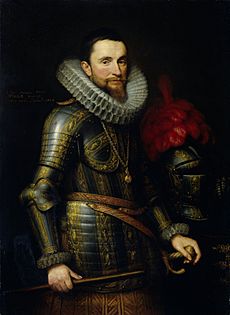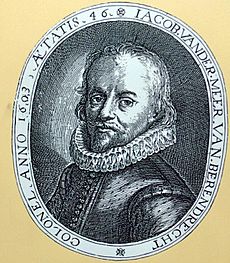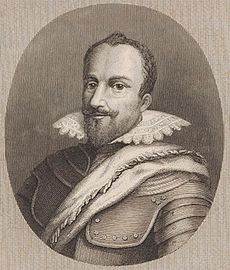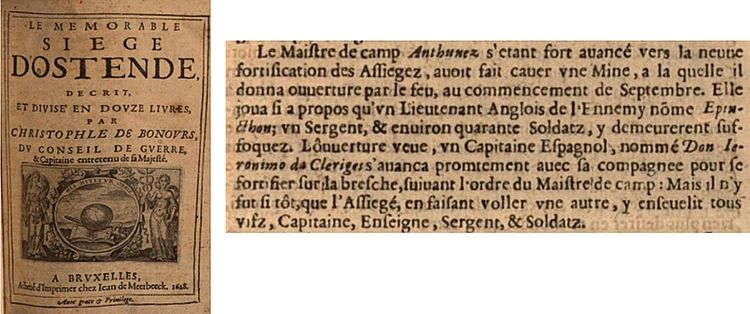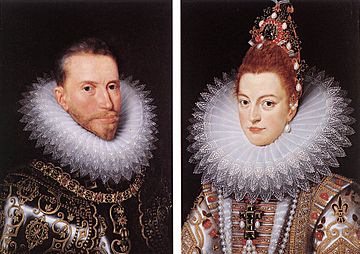Siege of Ostend facts for kids
Quick facts for kids Siege of Ostend |
|||||||||
|---|---|---|---|---|---|---|---|---|---|
| Part of the Eighty Years' War & the Anglo–Spanish War | |||||||||
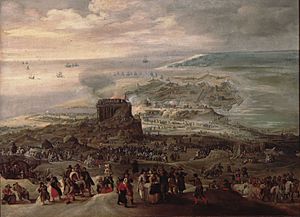 Siege of Ostend by Peter Snayers, oil on canvas. |
|||||||||
|
|||||||||
| Belligerents | |||||||||
| Commanders and leaders | |||||||||
| Strength | |||||||||
| 2,500–8,000 (peak) Total: ~50,000 (by rotation) |
9,000–20,000 (peak) Total: ~80,000 (by rotation) |
||||||||
| Casualties and losses | |||||||||
| 30,000 – 45,000 killed, wounded or succumbed to disease 3,000 surrendered |
60,000 – 70,000 killed, wounded or succumbed to disease | ||||||||
The Siege of Ostend was a very long battle that lasted for over three years. It happened in the city of Ostend (which is now in Belgium). This siege was a big part of two wars: the Eighty Years' War and the Anglo–Spanish War.
Spanish forces, led by Archduke Albrecht, tried to capture Ostend. The city was defended by Dutch troops, who were later joined by English soldiers led by Francis Vere. People at the time said, "the Spanish attacked the unassailable; the Dutch defended the indefensible." This means it was a really tough fight for both sides.
Ostend was the only area in Flanders controlled by the Dutch. Because of its importance, both sides fought incredibly hard. This made it one of the longest and bloodiest sieges in history. More than 100,000 people were killed, injured, or died from sickness during the battle.
Ostend could get supplies by sea, which helped it hold out for so long. Soldiers were regularly swapped out for fresh troops. This helped keep the number of deaths from fighting and disease lower for the defenders. The Spanish launched many attacks, including a huge one in January 1602 with 10,000 soldiers. This attack failed, and the Spanish lost many men.
After heavy losses, the Spanish leader, Archduke Albrecht, was replaced by Ambrosio Spinola. The siege then became a slow battle of attrition. This means they tried to wear down the defenders by slowly taking over their strong points.
Ostend finally fell to the Spanish on September 20, 1604. But the city was completely destroyed. Even though Spain won, it was a very costly victory. This kind of win is called a pyrrhic victory. The Dutch and English had also captured another important city, Sluis, just before Ostend fell. The huge cost and number of deaths from the Ostend siege helped lead to Spain's bankruptcy three years later. This also led to a Twelve Years' Truce, a break in the fighting.
Contents
Why the Siege Happened
In 1568, the Netherlands started fighting against Spain. This was because Spain ruled them, and the Dutch wanted to be independent. This conflict is known as the Eighty Years' War.
By 1579, the Dutch provinces were divided. Some joined the Union of Arras and stayed loyal to Spain. Others formed the Union of Utrecht and continued to fight for freedom. By 1588, Spain had taken back many southern areas. Ostend was one of the few places along the coast still held by the Dutch rebels.
At this time, Spain was also fighting wars with England and France. This gave the Dutch Republic a chance to fight back. From 1590 to 1600, the Dutch, led by Maurice of Orange, had many successes. This period was called the Ten Glory Years.
In 1601, Spain was still a powerful empire, but it was struggling financially. Years of war had made it very expensive. The Dutch Republic was also facing money problems from the long war. Both sides were trying to find ways to pay for the fighting.
In 1600, Dutch and English armies used Ostend as a base. They wanted to capture the city of Dunkirk. However, their plans changed, and they left Ostend. This left Ostend open to attack by the Spanish.
Ostend's Importance
Ostend was a small fishing village with about 3,000 people. But it was in a very important spot in West Flanders. It was right on the North Sea, which meant Dutch ships could easily reach it. The Dutch and English had built strong defenses there between 1583 and 1590. They turned it into a major military port.
For the Spanish, Ostend was a big problem. It was the only place in Flanders that the Dutch still controlled. The city had never been captured by the Spanish. Its soldiers often attacked nearby Spanish areas. Capturing Ostend was very important for Spain's plans.
How Ostend Was Defended
Ostend's defenses were very strong. The city was built near the sea. In 1583, the newer part of the town was fortified with thick walls and ditches. The sea was used to fill these ditches, surrounding the town with water.
- A canal called the Geule formed a new harbor on the east side. It was wide and deep, allowing ships to enter.
- To the south, there were many flooded streams and wetlands. This made it hard for the Spanish to bring heavy cannons close.
- On the west side, another canal, the Old Haven, acted like a defensive moat. It was hard to cross except at low tide.
- The city had many forts and strong points. These included the Sandhill, Schottenburgh, Moses Table, and Flamenburg.
- On the eastern side, there were bulwarks like the North Bulwark and East Bulwark.
- To the south and west, a large area called the Polder was also fortified. It had more bulwarks and ravelins (outer defenses).
- The Porcepic and Helmund were important forts on the northwest side. This area was considered the most vulnerable.
- The north side was open to the sea. This allowed Ostend to get supplies and fresh soldiers during the siege.
The Armies Fighting
Soldiers in this period used weapons like pikes (long spears), arquebuses (early guns), swords, and daggers. They also used early forms of hand grenades and cannons. Many more soldiers died from sickness and infection than from battle wounds.
The Spanish army had special units called tercios. These were considered some of the best soldiers in Europe. They were well-organized and disciplined. Spanish forces included soldiers from many parts of the Spanish Empire. These were Spaniards, Portuguese, Italians, Germans, and others. They were led by Archduke Albrecht.
The defenders of Ostend were from the Dutch Republic. Their army was well-organized by Maurice of Nassau. They had strong support from their ally, England. English soldiers, known for their red coats, were considered very experienced. Other Protestant soldiers from Scotland, France, and Germany also fought with the Dutch.
The Siege Begins (1601)
On July 5, 1601, Archduke Albert started the siege of Ostend. He had 12,000 men and 50 cannons. The small group of defenders, less than 2,000, was led by Governor Charles van der Noot. The Dutch leaders believed defending Ostend was extremely important. They chose Sir Francis Vere, a hero from a previous battle, to be the general in charge.
The Spanish army grew to 20,000 men. They fired cannons at the city. Some tried to cross the moat but drowned. The Spanish also tried to build a dike to block ships from reaching Ostend. But the sea and the Dutch-English navy kept interrupting their work. Because the Spanish couldn't fully block the sea, Ostend could still get supplies and new soldiers.
Vere first went to England to get permission from Queen Elizabeth I. He also recruited new soldiers. His brother, Horace, brought eight English companies to Ostend.
Vere Arrives
On July 9, Sir Francis Vere landed in Ostend with his troops. He took over command. The garrison now had 3,500 men, including Vere's soldiers. Another 1,500 English troops arrived later to strengthen the defense.
On July 27, English troops led by Edward Cecil attacked the Spanish trenches. They pushed the Spanish back, causing about 600 casualties.
On August 4, Vere was badly wounded in the head by Spanish cannon fire. He went to Middelburg to recover. In September, he returned to Ostend with more new soldiers from Holland, England, and Scotland.
The Spanish continued to bombard the city. The soldiers dug underground shelters for protection. Vere was frustrated that the Dutch leaders and Maurice of Nassau were not doing more to help Ostend. Maurice, however, decided to attack Spanish-held cities nearby to draw attention away from Ostend.
The Spy
The Archduke had a spy named Conisby. He was an Englishman who tried to help the Spanish. Conisby tried to bribe a sergeant to blow up the powder magazine. The sergeant told on him, and Conisby was caught. He was punished and forced out of the town.
Big Spanish Attacks
By December 1601, Ostend's defenders were down to less than 3,000 men. The Spanish also had many sick soldiers. For the first six months, about a thousand cannon shots were fired each day.
On December 4, the Spanish made a hole in Ostend's defenses. They prepared to storm the city. Vere made sure the area was heavily guarded. About 3,000 to 4,000 Spanish soldiers attacked. They managed to get into the hole, but the defenders fought back fiercely. The Spanish were pushed out and suffered heavy losses, over 500 men.
Vere's Clever Trick
By late December, Ostend was in a very dangerous situation. Vere knew he needed more time and soldiers. He pretended to want to talk about surrendering. This was a trick to gain time for reinforcements to arrive. The Spanish agreed to talks.
Vere sent two of his captains as hostages to the Spanish camp. The Spanish sent two of their own officers to Ostend. Vere then used many excuses to delay the talks. He pretended to be angry, then apologized, and even invited the Spanish officers to a Christmas Eve dinner.
While the talks were delayed, the defenders quickly repaired their walls. After 24 hours, three ships arrived with 600 new Dutch soldiers. Vere's trick had worked! He immediately ended all talks. The Spanish Archduke was furious, but he had to release Vere's captains.
Battles in 1602
In early January, the Spanish fired many more cannonballs at Ostend. The city was almost completely destroyed. Defenders used wood from ruined houses to build new defenses.
Huge Spanish Attack
Vere learned that the Spanish were planning a massive attack. He prepared his troops. He closed a water gate to keep as much water as possible in the city's ditches.
Ready for Battle
Horace Vere and Charles Fairfax led 12 companies of soldiers. Other companies were placed in key forts. Cannons were loaded with grape shot (small metal balls that spread out). Stones, bricks, and burning materials were ready to be thrown at the attackers.
The Spanish army gathered for a huge assault. About 10,000 men were ready to attack different parts of the city.
The Attack Begins
As night fell, the Spanish rushed forward. Vere ordered his engineers to quickly build a small wall. He told his soldiers not to fire until he gave the signal.
When the Spanish got close, Vere ordered a massive fire. The Spanish tried to climb the walls, but they were met with cannons, burning ash, stones, and flaming hoops. They were pushed back three times.
On the east side, the Spanish captured an outer fort called the "Spanish Half-moon." But Vere ordered a counterattack, and the English drove them out, capturing 300 Spanish soldiers.
By midnight, the Spanish were pushed back everywhere. Vere saw his chance. He ordered the water gate to be opened. The water that had been held back rushed down the haven in a huge flood. Many Spanish soldiers were swept away into the sea.
After the water went down, the defenders counterattacked. They rushed over the walls and took many supplies from the retreating Spanish. The Spanish were in complete chaos.
After the Attack
The Spanish suffered huge losses, between 1,500 and 2,000 soldiers were killed, wounded, or drowned. Many important leaders were also killed. The defenders lost only 40 killed and 100 wounded. Horace Vere was wounded in the leg.
After this big failure, many Spanish soldiers refused to fight. They blamed their leaders for the high number of deaths. Archduke Albert ordered some of the rebellious soldiers to be executed.
Vere Leaves Ostend
Vere stayed for a few more months. Then, the Dutch leaders called him away for another important command. Vere left Ostend on March 7, taking most of his English soldiers with him. But some English troops stayed to fight. Colonel Frederic van Dorp became the new governor. By June, the garrison had 5,000 men.
In July 1602, Maurice of Nassau launched an attack. He besieged the city of Grave and captured it in September.
There were no more big attacks on Ostend in 1602. But a disease spread through both armies, causing many deaths. New Dutch soldiers arrived in November, and more supplies came in December. The Spanish tried to stop the supply ships but failed.
Events in 1603
The siege continued in 1603 with both sides firing cannons. The Spanish still couldn't stop Dutch and English ships from bringing supplies to Ostend.
Peace Talks
Queen Elizabeth I of England died in March 1603. The new king, James I, started talking about peace with Spain. He stopped sending new English soldiers to Ostend and declared a ceasefire at sea. This was to try and start peace talks. However, English soldiers already fighting for the Dutch continued to do so.
The peace treaty between England and Spain was signed in 1604. It said England would not help the Dutch rebels. But this rule would only start after the Siege of Ostend ended. So, English and Scottish troops kept fighting in Ostend.
Attacks on the Outer Forts
On April 13, 1603, a storm hit Ostend, damaging the defenses. After the storm, the Spanish attacked the "Porcespic" fort with 8,000 soldiers. The fort was defended by Dutch, English, and Scottish troops, and the attack was pushed back.
However, this attack was a trick. While the fighting was happening at "Porcespic," Spanish soldiers secretly climbed over the walls of three other outer forts: the South Square, West Square, and Polder Square. The Spanish captured these three forts. Both sides suffered heavy losses in these attacks.
Even though they lost these forts, the defenders strengthened their inner defenses. The Spanish had taken the forts, but it had cost them many lives. Some Spanish leaders began to doubt Archduke Albert's leadership. They decided to replace him.
The Spinola Brothers
Two brothers from Genoa, Federico and Ambrosio Spinola, offered their help to the King of Spain. Federico tried to blockade Ostend by sea, but his ships were defeated by English and Dutch forces. He was killed in a battle in 1604.
Meanwhile, Ambrosio Spinola gathered 8,000 new soldiers from Italy. He used his own money and loans from bankers to pay for them.
After two years, Archduke Albert had not made much progress in the siege. He had failed to block the harbor or stop ships from coming in. The siege had cost a huge amount of money and soldiers.
In October 1603, Ambrosio Spinola took over command of the Spanish forces. Many were unsure about him because he didn't have much military experience. But he quickly earned the respect of his soldiers. He improved their morale and tried new ways to capture Ostend. He even brought in an inventor, Pompeo Targone, to create new siege machines.
The Dutch also got a new commander. Peter van Gieselles replaced Charles van der Noot in late 1603.
The Final Year (1604)
Ambrosio Spinola wanted to avoid the bloody, failed attacks of the past. Instead, he decided to use a slow, steady approach. His troops built trenches and fortifications that slowly moved closer to Ostend. This was a costly but effective method.
He ordered his troops to build raised paths across the Yperlet stream, protected by large baskets filled with earth. Some of the new inventions didn't work well. Targone's mobile bridge was quickly destroyed by cannon fire.
Between February and March 1604, severe storms damaged the city. The Spanish continued to dig trenches closer and started building a mine (a tunnel) under the "Porcepsic" and "West Bulwark" forts.
On March 12, the Spanish launched a strong attack on the "lesser Polder bulwark." They captured it. This was Spinola's first success using his new strategy. Soon after, Governor Gieselles was killed. He was replaced by Colonel John van Loon, who also died just four days later. Jacob van der Meer became the next commander on April 1.
The next day, the Spanish attacked the "Polder ravelin." After many hours of bloody fighting, they captured it. On April 18, Spinola ordered another attack on the "Western ravelin." After fierce hand-to-hand combat, this fort was also captured. The Spanish were now very close to the main defenses.
The Siege of Sluis
Maurice of Nassau was worried about Ostend. He decided to attack either Ostend or Sluis. He chose Sluis, hoping to draw the Spanish away from Ostend or capture Sluis as a backup port.
Maurice and his cousin William Louis of Nassau led a Dutch and English army of 11,000 men. They laid siege to Sluis on April 25. Spanish generals tried to help Sluis, but Maurice's forces held firm. Sluis surrendered on August 19.
New Troy
Because the old defenses were falling, the commander, van der Meer, ordered a new inner wall to be built. This new defense was called Nova Troia, or New Troy. It was named after the ancient city of Troy, which was famous for its long defense. The new defenses were given names like New Helmund and New Polder.
By May 11, the Spanish had taken a part of the "Porcepsic." Van der Meer warned that the defenders were exhausted. He died shortly after from a musket wound. Colonel Uytenhoove took his place.
On May 29, the Spanish blew up their mine under the "Porepsic." They attacked the breach. After fierce fighting, the "Porepsic" was finally captured by the Spanish. However, their attack on the "Polder" bulwark failed.
On June 2, another Spanish mine under the "Polder" bulwark exploded. The Spanish attacked, but they were surprised. The defenders had figured out where the mine was. They had built new defenses (the New Polder) directly behind the old one. The Spanish were met with heavy fire and pushed back with more losses. Spinola stopped attacks for two weeks.
On June 7, more reinforcements arrived in Ostend: five companies, including English and Scottish troops.
On June 17, the Spanish blew up their mine under the "Western bulwark." They attacked, but the defenders fought back hard. Governor Uytenhoove was badly wounded. The Spanish finally captured the "Polder bulwark," but the defenders retreated to their inner walls. Both sides lost many men. Daniel d'Hertaing became the new and final commander of Ostend.
On July 25, a convoy brought 800 new soldiers to Ostend. This was the last major reinforcement. Soon after, bad storms damaged Ostend's defenses. It became very hard for Dutch supply ships to reach the city.
On August 22, two days after Sluis surrendered, a combination of high tide and another storm destroyed a large part of the New Troy defenses. The northern defenses were abandoned. By September 13, the Spanish took control of areas that had held them off for nearly three years. They started firing cannons at the old town. The situation was hopeless for the defenders. The long, bloody battle of attrition had finally worked for the Spanish.
Surrender
Maurice's capture of Sluis meant that holding Ostend was no longer as important for the Dutch. The Dutch leaders decided to allow the Ostend garrison to surrender. Daniel d'Hertaing sent away any Spanish deserters or troublemakers. Fighting continued until the very last days. Charles Fairfax, an English commander, was killed on September 17.
Finally, on September 20, 1604, d'Hertaing surrendered the city to Ambrosio Spinola. The defenders were allowed to march out with their flags flying and drums beating. They went to Flushing safely. Spinola even hosted a dinner for the officers.
What Happened Next
The Spanish and their allies lost between 60,000 and 70,000 men during the siege. The Dutch and their allies lost between 30,000 and 40,000. Records show that nearly 1,000 healthy soldiers were needed every month to replace those who were injured, dead, or sick.
After the surrender, the Spanish army entered a completely destroyed city. It was a wasteland of rubble. Of the 3,000 civilians in Ostend, most had left early in the siege. Only two civilians remained at the end.
Ambrosio Spinola was made a top commander in the Spanish army. Juan de Ribas became the new Governor of Ostend.
The defenders of Ostend arrived at the newly captured Sluis. Maurice welcomed them with honor. Officers and soldiers were promoted and rewarded.
The Spanish leaders tried to use the capture of Ostend as a victory for their side. But the huge cost in money and lives made it a propaganda failure. Both sides were exhausted from the long siege. This led to a short truce in 1604-1605.
Spinola continued to lead the Spanish army, making some gains in Dutch territory. But the Spanish could not repeat the successes Maurice had achieved earlier. The huge cost of the Ostend siege and Spinola's later campaigns exhausted Spain's treasury. In November 1607, Spain declared bankruptcy.
The balance of power meant both sides were tired of fighting. After decades of war, they were ready for peace talks. This led to the Twelve Years' Truce in 1609. The draining Siege of Ostend is often called a Pyrrhic victory for Spain because the cost was so high.
New Ways of War
Because Ostend was supplied by sea, normal siege methods didn't work well. Spanish military engineers had to invent new ways to try and capture the town. The Italian architect Pompeo Targone designed many devices, but most of them were not very effective.
A School for Soldiers
Historians like John Lothrop Motley said that the Siege of Ostend became like a "great academy" or "military school of Europe." Soldiers and officers from all over Europe came to learn about war from the skilled commanders there. Many young noblemen came to watch and learn.
Fun Facts and Stories
- The Ostend siege was widely reported in newspapers and pamphlets at the time. One newspaper, "Belägerung der Statt Ostende," was translated into many languages.
- Artists like Sebastian Vrancx, Cornelis de Wael, and Peter Snayers created paintings and prints of the siege.
- Cartographers Floris Balthasar and Joan Blaeu drew maps of the siege.
- Don Giovanni de' Medici wrote many reports about Pompeo Targoni's military inventions. He even ordered a huge model of the town and its defenses to be made.
- Famous historians like Guido Bentivoglio and Hugo Grotius wrote about their experiences during the siege.
- The writer Cyril Tourneur, who was at Ostend, mentioned Francis Vere's clever trick (the parley stratagem) in one of his plays.
- In 1603, the Dutch made a special coin to remember the siege. It showed a fox (representing Spain) looking up at a rooster (representing Ostend) in a tree. This was a joke based on Aesop's fable about flattery.
- The Spanish fired so many cannonballs at the city that the defenders piled them up outside the walls. New cannon shots would then bounce off them like marbles!
Images for kids
See also
 In Spanish: Sitio de Ostende para niños
In Spanish: Sitio de Ostende para niños




